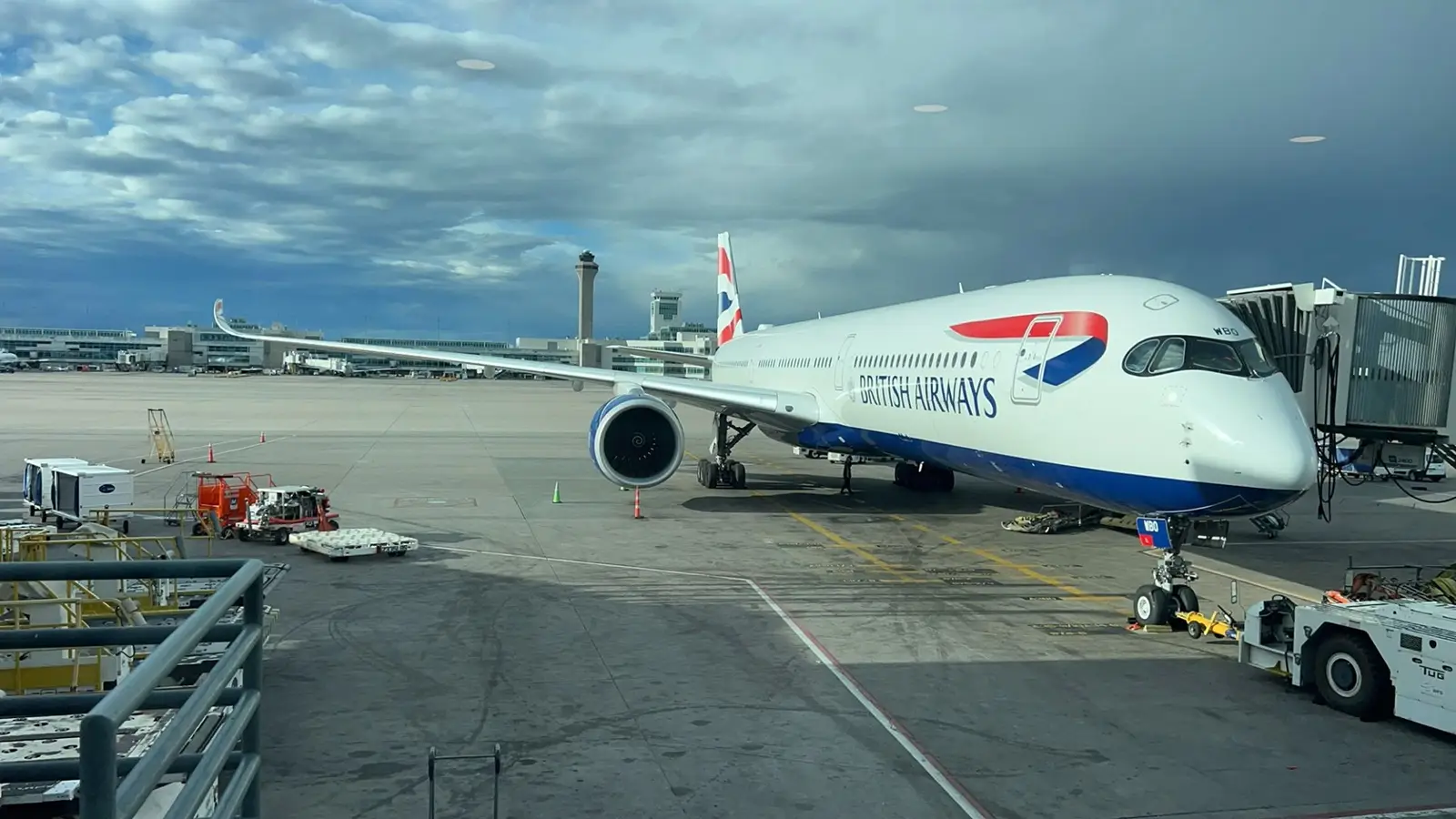
The Airbus A350-1000 has long been British Airways’ flagship widebody jet, an aircraft capable of ultra-long-haul operations. The model’s extended-range capabilities make it exceptionally suited for serving high-capacity markets that are located very far apart. The jet’s ultra-wide cabin makes it ideal for premium cabins, offering exceptional comfort to passengers through the form of wider seats. Currently, legacy airlines like British Airways have become exceptionally focused on serving international travel markets that feature large amounts of premium demand. These carriers emphasize the development of premium cabins with numerous cutting-edge features, helping them offer an exceptional passenger experience.
There are relatively few routes that can support the impressive amount of premium capacity that the British Airways Airbus A350-1000 can accommodate. Services will be flagship, high-capacity routes to key business-travel-oriented destinations within the airline’s network, all of which originate from its principal hub at London Heathrow Airport (LHR). Legacy players like British Airways have been known to historically use widebody jets to service flagship routes, and the UK’s principal flag carrier is no exception to this rule. We analyze the British Airways Airbus A350 fleet in detail, discuss the ways the airline deploys these unique aircraft, and evaluate the long-term role the aircraft plays within the airline’s fleet.
A Deeper Look At The British Airways Airbus A350-1000
British Airways operates the Airbus A350-1000 as the newest long-haul wide-body in its fleet, offering an impressive combination of efficiency and range that is appealing to the operator. This aircraft was also used to roll out its flagship Club Suite. This fleet, which was delivered from 2019 onwards, replaced aging Boeing 747-400 jets and standardized British Airways’ premium hard products. This includes a 1-2-1 business-class cabin with sliding doors and direct aisle access. Seats are also equipped with large side tables and offer ample storage for customers.
The typical layout for cabins is 331 seats, including 56 Club Suites, 56 World Traveller Plus (British Airways’ premium economy), and 219 World Traveller seats. An aircraft powered by Rolls-Royce Trent XWB engines, the Airbus A350-1000 brings double-digit fuel-burn and noise reductions over legacy aircraft, helping British Airways meet the hefty noise and carbon emissions constraints put in place by Heathrow Airport. This helps improve trip economics, especially on long and dense sectors.
From an operational standpoint, British Airways uses the Airbus A350-1000 primarily for its transatlantic trunk routes, its long Middle East and India routes, and select flights to markets in Africa and Asia where demand is strong, and airport noise slots are tight. The aircraft’s range and payload help comfortably support 8-12-hour missions while freeing up Boeing 777-300ER jets for other kinds of routes. These aircraft are equipped with the latest and most capable cabin systems, including in-flight entertainment with Bluetooth, high-capacity galleys, and modern air pressure systems, significantly improving reliability while reducing aircraft turn times. From a network perspective, the Airbus A350 is the fleet’s workhorse, and it delivers the Club Suite at scale. At the same time, the aircraft brings along relatively low fuel costs.
How Does British Airways Use The Airbus A350-1000?
British Airways currently deploys the Airbus A350-1000 primarily on long-haul, premium-dense sectors and to airports that face slot restrictions. It is under these circumstances that trip-cost efficiencies and the ability to offer ultra-premium Club Suites to the market are most important. Starting in October 2025, the aircraft will be operating services to a variety of destinations across British Airways’ diverse global route network. For starters, the model will fly from London Heathrow Airport (LHR) to Tokyo-Haneda Airport (HND), Hong Kong International Airport (HKG), and Delhi Airport (DEL) on the Asian continent.
Beyond Asia, the aircraft will also operate nonstop services to São Paulo (GRU), Cape Town (CPT), Nairobi (NBO), and Toronto (YYZ). Beyond this, the model will serve Las Vegas (LAS), Phoenix (PHX), Denver (DEN), and Philadelphia (PHL) with daily flights. This pattern will blend thick leisure and business travel trunk routes with high-yield strategic pillars in Asia, Africa, and India. The Airbus A350’s lower fuel burn and cabin consistency will let British Airways protect its margins while continuing to win over corporate market share.
The Airbus A350-1000 also allows the airline to preserve key landing spots at Heathrow Airport for larger Boeing 777-300ER and Boeing 787 models. The aircraft can also be used to serve shoulder season demand, while daily frequencies on longer-stage missions demonstrate the airline’s ability to be extremely productive. Across the board, British Airways uses the Airbus A350-1000 as a quiet, fuel-efficient flagship jet that can support premium-heavy origin and destination traffic on 8-14 hour sectors.
A350-1000 Capacity, Frequency, And Operating Economics
Across October, the Airbus A350-1000 will operate more than 160 flights, flying more than 52,000 seats per week and providing the carrier with more than 258 million revenue-generating available seat miles (ASMs), according to data provided to Simple Flying by aviation industry database Ciricum Aviation Analytics. This indicates both high average stage lengths and strong aircraft utilization. The heaviest individual stage markets are those from London to Hong Kong and Cape Town, both of which measure nearly 6,000 miles (9,500 km) and push the limits of the aircraft’s range.
Routes to India and Africa, as well as the carrier’s service to Brazil, also run daily, underscoring the airline’s willingness to use the aircraft to serve long-haul flow traffic where the A350’s cost per available seat mile (CASM) and overall noise footprint outperform legacy twin-engine models. North American destinations mostly serve as leisure and business spokes in the airline’s network, helping maintain a dynamic network balance all across the United States.
It is also important to note that the airline serves Toronto Pearson with a three-times-per-week service, offering incremental North American reach without oversupplying demand during the interim months. This mix allows the carrier to deliver consistent Club Suite products and helps simplify the maintenance and training process for the airline while supporting yield management and pairing premium-dense cabins with routes exhibiting strong corporate contracts and inbound tourism.
How Does The Airbus A350 Fit Into The British Airways Fleet?
The Airbus A350-1000 is the next-generation widebody workhorse for British Airways, and, when it was introduced, it was intended to replace older-generation Boeing 747s and early-generation Boeing 777s. The jet standardized the door-equipped Club Suite, and it offered optimal efficiency for 8-14-hour missions where Heathrow slot and night-curfew constraints reward efficient aircraft capable of quick turnaround times.
In comparison to the Boeing 777-300ER, the aircraft offers similar seats with better fuel burn capabilities and quieter operations, so that British Airways can save its Boeing 777-300ER jets for cargo-heavy routes. The A350-1000 carries more passengers than the Boeing 787, while also beating out the range of the Boeing 787-10, that family’s largest variant.
In comparison to massive jumbo jets like the Airbus A380, the A350-100 offers day-to-day flexibility, with two daily A350s roughly offering the same capacity as a single A380. From an operational perspective, the aircraft delivers a consistent hard product and supports yield management on premium-heavy markets all across Asia, Africa, and the Americas.
What Are The Longest British Airways Airbus A350-1000 Routes?
British Airways currently assigns its Airbus A350-1000 fleet to the longest, most demanding sectors that it flies. This is because the aircraft’s combination of fuel burn, noise limitations, and premium cabin consistency matters the most on these kinds of routes.
While the longest route pairs can be seen in the table below, none of these should surprise you. These are all destinations that cleanly fit the jet’s operational profile.
The aircraft is well-equipped to cater to premium traffic, making it a workhorse on long-haul international routes, which are frequented by British and international business travelers. This also frees up Boeing 777s for ultra-long-haul routes, where their cargo capabilities make them a key revenue-generating asset.
What’s The Bottom Line?
At the end of the day, British Airways’ deployments of its Airbus A350 fleet are similar in style to those of many competitors. Legacy airlines are looking to get as much value out of these jets as possible.
The Airbus A350 is, at the end of the day, an ultra-long-haul flagship jet with exceptional range and payload capabilities. The model’s impressive range and capacity make it ideal for these kinds of services.
Beyond that, the jet is able to maintain an exceptional reputation for passenger comfort. There are relatively few aircraft in the skies today that can offer as comfortable a ride, much less with the impressive fuel efficiency of the Airbus A350.



